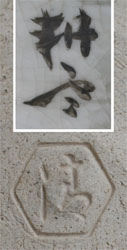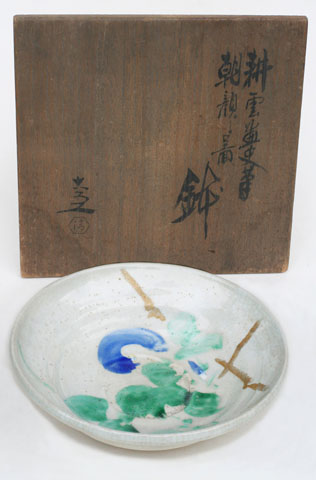Nihonga / Kyoyaki
Kashibachi - bowl for sweets: Asagao - Morning glorySigned: Kôun
Seals: Kiyo
Technique: Grey crackled Kyoyaki, with a blue and green underglaze painting and over glaze gold addition Ø 21 x 6,5
Box: signed by both potter and painter
Condition: fine
Kôun was born and lived in Kyôto and was a pupil of Kikuchi Hôbun (1862-1918). He was a prize winner at the Naikoku Kangyô Hakurankai and on a number of Bunten exhibitions. From 1915 -1918 he worked with his teacher Hôbun in The Hague at the Japanese room in the 'Peace Palace'.
Reference:
Roberts p. 195
Aburai p. 406
Araki p. 1558
Rokubei V was born in Kyoto, the second son of Kiyomizu Rokubei IV. He studied Shijô painting with Kôno Barei, adopting the artist’s name Shôrei. He also studied at the Kyoto Prefectural School of Painting, and studied ceramic techniques with his father after graduation. His career as a ceramic artist began when he won a prize at the Fourth Domestic Industrial Exposition in 1895. He studied glazing techniques at the Kyoto Municipal Ceramic Laboratory established in 1896 and organized the Promoting Society for Craft Workers (Shokkô Shôrei-kai) with designer Kikuchi Sokû at the Laboratory in 1899. He actively worked on the study and research of new glazing techniques and (Western) designs.
When Rokubei IV retired, he inherited the title and became Rokubei V in 1913. He exhibited at the Nôten, the Design and Applied Artworks Exhibition sponsored by the Ministry of Agriculture and Commerce and the Teiten, the Imperial Art Academy Exhibition. He also became a member of the Imperial Art Academy and played an important role as a leading figure of the craft world. In 1945 he retired and took the artist’s name Rokuwa.
Reference:
Kyoto ‘03, ’Sekka’ p. 326 ff.
Price: ON REQUEST

